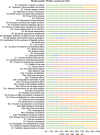Evaluating the Cost-Utility of Continuous Glucose Monitoring in Individuals with Type 1 Diabetes: A Systematic Review of the Methods and Quality of Studies Using Decision Models or Empirical Data
- PMID: 38904911
- PMCID: PMC11343921
- DOI: 10.1007/s40273-024-01388-6
Evaluating the Cost-Utility of Continuous Glucose Monitoring in Individuals with Type 1 Diabetes: A Systematic Review of the Methods and Quality of Studies Using Decision Models or Empirical Data
Abstract
Introduction: This review presents a critical appraisal of differences in the methodologies and quality of model-based and empirical data-based cost-utility studies on continuous glucose monitoring (CGM) in type 1 diabetes (T1D) populations. It identifies key limitations and challenges in health economic evaluations on CGM and opportunities for their improvement.
Methods: The review and its documentation adhered to the Preferred Reporting Items for Systematic Reviews and Meta-Analyses (PRISMA) guidelines for systematic reviews. Searches for articles published between January 2000 and January 2023 were conducted using the MEDLINE, Embase, Web of Science, Cochrane Library, and Econlit databases. Published studies using models and empirical data to evaluate the cost utility of all CGM devices used by T1D patients were included in the search. Two authors independently extracted data on interventions, populations, model settings (e.g., perspectives and time horizons), model types and structures, clinical outcomes used to populate the model, validation, and uncertainty analyses. They subsequently met to confirm consensus. Quality was assessed using the Philips checklist for model-based studies and the Consensus Health Economic Criteria (CHEC) checklist for empirical studies. Model validation was assessed using the Assessment of the Validation Status of Health-Economic decision models (AdViSHE) checklist. The extracted data were used to generate summary tables and figures. The study protocol is registered with PROSPERO (CRD42023391284).
Results: In total, 34 studies satisfied the selection criteria, two of which only used empirical data. The remaining 32 studies applied 10 different models, with a substantial majority adopting the CORE Diabetes Model. Model-based studies often lacked transparency, as their assumptions regarding the extrapolation of treatment effects beyond available evidence from clinical studies and the selection and processing of the input data were not explicitly stated. Initial scores for disagreements concerning checklists were relatively high, especially for the Philips checklist. Following their resolution, overall quality scores were moderate at 56%, whereas model validation scores were mixed. Strikingly, costing approaches differed widely across studies, resulting in little consistency in the elements included in intervention costs.
Discussion and conclusion: The overall quality of studies evaluating CGM was moderate. Potential areas of improvement include developing systematic approaches for data selection, improving uncertainty analyses, clearer reporting, and explaining choices for particular modeling approaches. Few studies provided the assurance that all relevant and feasible options had been compared, which is required by decision makers, especially for rapidly evolving technologies such as CGM and insulin administration. High scores for disagreements indicated that several checklists contained questions that were difficult to interpret consistently for quality assessment. Therefore, simpler but comprehensive quality checklists may be needed for model-based health economic evaluation studies.
© 2024. The Author(s).
Conflict of interest statement
Peter R. van Dijk received financial support and study materials from Menarini Diagnostics and study materials from Abbott Diabetes Care and Dexcom Inc. Talitha L. Feenstra participated in the development of the ADVISHE checklist. Lisa A. de Jong, Xinyu Li, Sajad Emamipour, Sjoukje van der Werf, and Maarten J. Postma declare no competing interests.
Figures






Similar articles
-
Model and Empirical Data-Based Cost-Utility Studies of Continuous Glucose Monitoring in Individuals with Type 1 Diabetes: A Protocol of a Systematic Review on Methodology and Quality.Pharmacoecon Open. 2023 Nov;7(6):1007-1013. doi: 10.1007/s41669-023-00428-9. Epub 2023 Aug 22. Pharmacoecon Open. 2023. PMID: 37608071 Free PMC article. Review.
-
Behavioural interventions for type 2 diabetes: an evidence-based analysis.Ont Health Technol Assess Ser. 2009;9(21):1-45. Epub 2009 Oct 1. Ont Health Technol Assess Ser. 2009. PMID: 23074526 Free PMC article.
-
The future of Cochrane Neonatal.Early Hum Dev. 2020 Nov;150:105191. doi: 10.1016/j.earlhumdev.2020.105191. Epub 2020 Sep 12. Early Hum Dev. 2020. PMID: 33036834
-
Beyond the black stump: rapid reviews of health research issues affecting regional, rural and remote Australia.Med J Aust. 2020 Dec;213 Suppl 11:S3-S32.e1. doi: 10.5694/mja2.50881. Med J Aust. 2020. PMID: 33314144
-
Techniques of monitoring blood glucose during pregnancy for women with pre-existing diabetes.Cochrane Database Syst Rev. 2019 May 23;5(5):CD009613. doi: 10.1002/14651858.CD009613.pub4. Cochrane Database Syst Rev. 2019. PMID: 31120549 Free PMC article.
References
-
- Song MY, Steinhubl SR, Topol EJ. The beginning of the end of fingersticks? The Lancet. 2018;392:203. 10.1016/S0140-6736(18)31576-9 - DOI
Publication types
MeSH terms
Substances
LinkOut - more resources
Full Text Sources
Medical
Miscellaneous

